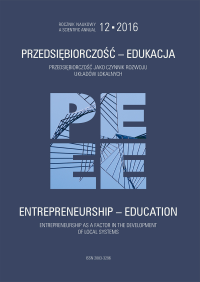The Role of Geoinformation in Partnership Between Local Government Units and Business
DOI:
https://doi.org/10.24917/20833296.12.6Keywords:
geoinformacja, integracja danych, planowanie przestrzenne, polityka przestrzenna, zagospodarowanie przestrzenne, zarządzanie przestrzeniąAbstract
The article underlines the integrative role of geo-information in support of policies and shaping of the concept of Smart City based on partnership. The movie Smart city Aarhus, presented at a conference in Gdansk on 25 September 2015 - Project Ecology Constructively3 - was an inspiration to write the article. To manage the space well, with the participation of the stakeholders interested in sustainable development of the territory, a complete, good quality information about the spatial policies is needed. The object of the research conducted in 2010-2012 was to present complex issues related to the implementation of the INSPIRE Directive in Poland in the subject of “land use” and the identification of relevant data sets, which should be made available in the established European Spatial Information Infrastructure (IIP). A summary of the results of qualitative research is presented, the author also shows the topicality of the posed thesis, most essentially associated with the lack of Polish definition of “planning document”, one of the main causes of reported problems. The article presents a reflection on the sidelines of the analysis of the results of the contract, the first in Poland, entitled “The Elaboration of Draft Standard Models of Planning Data and Metadata Profile for Planning Studies” (2011) and quotes statements from interviews of professionals (2011-2012).The current legal status has been presented and the elaborations of other authors were invoked in the article, showing the most controversial interpretations of the application of the regulations, and finally recommendations for further action were presented as the voice of the author in the ongoing discourse.References
Annoni, A. (2011). Inspire and the Digital Agenda for Europe, Spatial Information for Poland and Europe. Annals of Geomatics, IX(5),PTIP, Warszawa.
Borsa, M. (2015). Polityka przestrzenna w Polsce w latach 2004–2013. Wybrane regionalne i lokalne polityki publiczne w Polsce. Ministerstwo Infrastruktury i Rozwoju.
Domański, T., Markowski T. (red.) (2002). Skuteczna promocja miasta i regionu podstawowym zadaniem marketingu terytorialnego Marketing terytorialny, Studia Komitetu Przestrzennego Zagospodarowania Kraju PAN, T. CXII, Warszawa.
Dyrektywa 2007/2/WE Parlamentu Europejskiego i Rady z 14.03.2007 ustanawiająca Infrastrukturę Informacji Przestrzennej we Wspólnocie Europejskiej.
D2.8.III.4 Data Specification on Land Use – Draft Guidelines. (2015, 12 listopada). Pozyskano z: http:// inspire.ec.europa.eu/documents/Data_Specifications/INSPIRE_DataSpecification_LU_v3.0.pdf
Engelke, D. (2008; 2015, 12 listopada). “FLAIR Project reference” in Land Use Management for Sustainable European Cities (LUMASEC) Baseline study. Pozyskano z: http://urbact.eu/fileadmin/ Projects/LUMASEC/outputs_media/LUMASEC_Baseline_Study.pdf
Ekologia konstruktywnie – projekt Collegium Mazovia, Siedlce i Ministerstwo Ochrony Środowiska. (2015, 12 listopada). Pozyskano z: www.ekologiakonstruktywnie.pl
Hanzl, M. (2012, 10 grudnia). Monitoring procesów zagospodarowania przestrzennego na poziomie gminnym z zastosowaniem technologii SIP. Pozyskano z: http://ptip.org.pl//download/files/RG2007z4- Hanzl3.pdf.
Informatiemodel Ruimtelijke Ordering 2012 IMRO2012. (2015, 12 listopada). Pozyskano z: http://ro-standaarden.geonovum.nl/2012/IMRO/1.2/IMRO2012-v1.2.pdf
Jarczewski, W. (2007). Duch przedsiębiorczości w proinwestycyjnych działaniach władz lokalnych – Kraków. Przedsiębiorczość – Edukacja, 3, 71–80.
Kotler, P., Asplund, C., Rein I., Haider, D., (1999). Marketing places Europe. London: Pearson Education.
Malczewski, P. (2015, 12 listopada). Autorska ocena projektu standardowych modeli danych oraz profilu metadanych dla opracowań planistycznych oraz „Profilu Metadanych Plan4All” wraz z autorską analizą w zakresie branżowego profilu metadanych w zagospodarowaniu przestrzennym pod katem rożnic i skutkow dla tworzonej infrastruktury informacji przestrzennej wynikające z doświadczeń projektowych – Seminarium 1–2 grudzień 2011. Pozyskano z: https://www.igpim.pl/wp-content/ uploads/2013/01/Profil_metadanych_PM.pdf
Parzyński, Z., Chojka, A. (2013). Infrastruktura Informacji Przestrzennej w UML. Geodeta Sp. z o.o.
Płaziak M., Rachwał, T. (2015). „Przedsiębiorczy region” – zarys koncepcji w świetle analizy roli przedsiębiorczości w krajowej strategii rozwoju regionalnego, Przedsiębiorczość – Edukacja, 11, 37–49.
Rozporządzenie Komisji (UE) nr 1253/2013 z dnia 21 października 2013 r. zmieniające rozporządzenie (UE) nr 1089/2010 w sprawie wykonania dyrektywy 2007/2/WE Parlamentu Europejskiego i Rady dotyczące operacyjności zbiorow i usług danych przestrzennych.
Rossa, M., Gogołek, W., Łukasiewicz, A. (2009). Geostandardy, metadane i dyrektywa INSPIRE: poradnik metodyczny Zintegrowanego Systemu Kartografii Geologicznej IKAR, Państwowy Instytut Geologiczny, Państwowy Instytut Badawczy. Warszawa
Schrank, M., Neuschmis, J., Petti, D., Wassenburger, W. (2012, 10 sierpnia). Interoperability, SDI and spatial planning, Plan4all Project Interoperability. Pozyskano z: www.Plan4all.eu/extractor / fileReader.php?file=plan4all-book-web.pdf
Stelmach-Fita, B. (2011). Udostępnienie treści planistycznych w celu zintegrowanego zarządzania przestrzenią miejską, Miasto zwarte. Miasto rozproszone. Materiały ogolnopolskiej konferencji Doktorantów Wydziału Architektury, Warszawa, 4–5.11.2011.
Stelmach-Fita, B. (2012). Publiczny dostęp do danych o zagospodarowaniu przestrzennym w celu zintegrowanego zarządzania przestrzenią miejską: potrzeby i ograniczenia (rozprawa doktorska, obrona w 2013), Wydział Architektury Politechniki Warszawskiej.
Stelmach-Fita B. (2014). Publiczny dostęp do danych o zagospodarowaniu przestrzennym: potrzeby i ograniczenia, Współczesne uwarunkowania gospodarowania przestrzenią – szanse i zagrożenia dla zrównoważonego rozwoju, Seria Monografie, Gospodarka Przestrzenna.
Strzelecki, Z. (2015). Rozdział I. Polityka regionalna w Polsce w latach 2004–2013. Wybrane zagadnienia regionalne i lokalne. Polityki publiczne w Polsce, Ministerstwo Infrastruktury i Rozwoju.
Ustawa z dnia 4 marca 2010 roku o infrastrukturze i informacji przestrzennej (Dz.U. 2010 nr 76 poz. 489 z poźn. zm.).
Wells, L., Wint, A., (2000), Marketing a country: promotion as a tool for attracting foreign investment. Washington Duch FIAS.
Downloads
Published
How to Cite
Issue
Section
License
Articles are published under the terms of the Creative Commons License (CC BY-ND 4.0; Attribution– NoDerivs).

